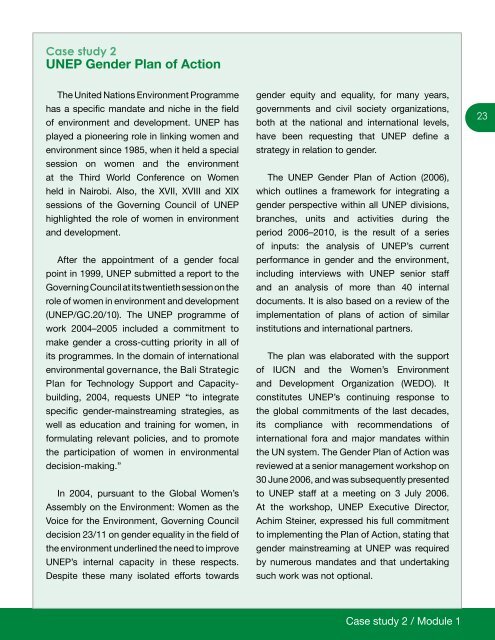GGCA Gender and Climate Change Training Manual - Women's ...
GGCA Gender and Climate Change Training Manual - Women's ...
GGCA Gender and Climate Change Training Manual - Women's ...
You also want an ePaper? Increase the reach of your titles
YUMPU automatically turns print PDFs into web optimized ePapers that Google loves.
Case study 2<br />
UNEP <strong>Gender</strong> Plan of Action<br />
The United Nations Environment Programme<br />
has a specific m<strong>and</strong>ate <strong>and</strong> niche in the field<br />
of environment <strong>and</strong> development. UNEP has<br />
played a pioneering role in linking women <strong>and</strong><br />
environment since 1985, when it held a special<br />
session on women <strong>and</strong> the environment<br />
at the Third World Conference on Women<br />
held in Nairobi. Also, the XVII, XVIII <strong>and</strong> XIX<br />
sessions of the Governing Council of UNEP<br />
highlighted the role of women in environment<br />
<strong>and</strong> development.<br />
After the appointment of a gender focal<br />
point in 1999, UNEP submitted a report to the<br />
Governing Council at its twentieth session on the<br />
role of women in environment <strong>and</strong> development<br />
(UNEP/GC.20/10). The UNEP programme of<br />
work 2004–2005 included a commitment to<br />
make gender a cross-cutting priority in all of<br />
its programmes. In the domain of international<br />
environmental governance, the Bali Strategic<br />
Plan for Technology Support <strong>and</strong> Capacitybuilding,<br />
2004, requests UNEP “to integrate<br />
specific gender-mainstreaming strategies, as<br />
well as education <strong>and</strong> training for women, in<br />
formulating relevant policies, <strong>and</strong> to promote<br />
the participation of women in environmental<br />
decision-making.”<br />
In 2004, pursuant to the Global Women’s<br />
Assembly on the Environment: Women as the<br />
Voice for the Environment, Governing Council<br />
decision 23/11 on gender equality in the field of<br />
the environment underlined the need to improve<br />
UNEP’s internal capacity in these respects.<br />
Despite these many isolated efforts towards<br />
gender equity <strong>and</strong> equality, for many years,<br />
governments <strong>and</strong> civil society organizations,<br />
both at the national <strong>and</strong> international levels,<br />
have been requesting that UNEP define a<br />
strategy in relation to gender.<br />
The UNEP <strong>Gender</strong> Plan of Action (2006),<br />
which outlines a framework for integrating a<br />
gender perspective within all UNEP divisions,<br />
branches, units <strong>and</strong> activities during the<br />
period 2006–2010, is the result of a series<br />
of inputs: the analysis of UNEP’s current<br />
performance in gender <strong>and</strong> the environment,<br />
including interviews with UNEP senior staff<br />
<strong>and</strong> an analysis of more than 40 internal<br />
documents. It is also based on a review of the<br />
implementation of plans of action of similar<br />
institutions <strong>and</strong> international partners.<br />
The plan was elaborated with the support<br />
of IUCN <strong>and</strong> the Women’s Environment<br />
<strong>and</strong> Development Organization (WEDO). It<br />
constitutes UNEP’s continuing response to<br />
the global commitments of the last decades,<br />
its compliance with recommendations of<br />
international fora <strong>and</strong> major m<strong>and</strong>ates within<br />
the UN system. The <strong>Gender</strong> Plan of Action was<br />
reviewed at a senior management workshop on<br />
30 June 2006, <strong>and</strong> was subsequently presented<br />
to UNEP staff at a meeting on 3 July 2006.<br />
At the workshop, UNEP Executive Director,<br />
Achim Steiner, expressed his full commitment<br />
to implementing the Plan of Action, stating that<br />
gender mainstreaming at UNEP was required<br />
by numerous m<strong>and</strong>ates <strong>and</strong> that undertaking<br />
such work was not optional.<br />
23<br />
Case study 2 / Module 1

















